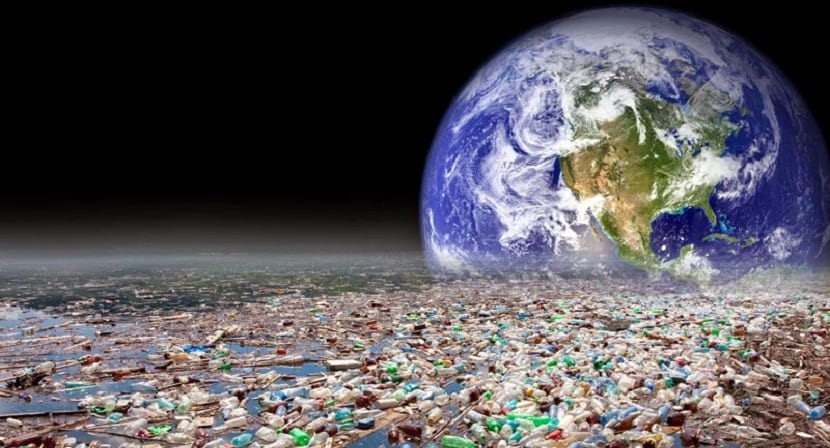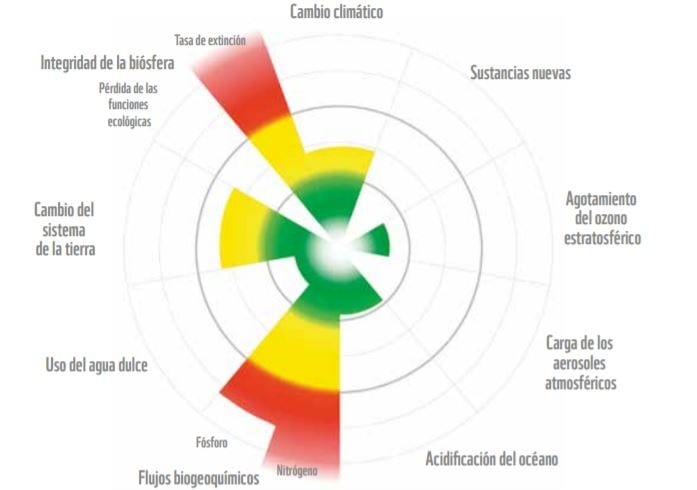
As we saw in the article Economic growth or environmental sustainability?There are people who believe that economic growth is infinite in time. But the reality is somewhat different. Economic growth is based on the exploitation and use of the natural resources that our planet offers us. But those resources are limited and their regeneration rate must be lower than the exploitation rate in order to continue taking advantage of them. That end is known as planetary limits.
The human being, after the industrial revolution, has increased the world population exponentially and this has led to an increase in the exploitation of natural resources. That exploitation is so huge that has already exceeded the carrying capacity of ecosystems, leading to an ecological deficit.
There are 9 planetary limits: Rate of extinction of animals, climate change, depletion of the ozone layer, acidification of the oceans, biogeochemical flows, use of fresh water, changes in the Earth system, loss of biodiversity and its functions and new substances.
Today the consumption and production patterns of our economic system have already made up to four of the nine planetary boundaries. These limits are what guarantee the proper functioning of the Earth and all its complex systems that work with a sensible balance.
Climate change, the rate of extinction of species, changes in land use and the biogeochemical fluxes of phosphorus and nitrogen are the subsystems that have already been exceeded. This means that increases the risk which entails continuing to carry out human activities at this rate. Some scientific evaluations are working to confirm whether the use of fresh water is already exceeded and added to the list of planetary limits that exceed the safe threshold.
Nature has a way of being able to absorb the impacts of human beings in its ecosystems and it is thanks to these physical and biological characteristics that our planet has remained stable for many years that we can live in "harmony". However, there is a scientific uncertainty before the effects that the distortion of these patterns that keep the planet stable could cause. That is why we find ourselves in an uncertain future that may be accompanied by irreversible changes on the resources we depend on to live.

As for the fresh water limit, the safe operating range for the use of water is being studied. What is known thanks to the Living Planet Index is that fresh water shows that it has been lost 81% of species populations between 1970 and 2012.
On the other hand, the limit of climate change is measured by the concentrations of CO2 in the atmosphere and other greenhouse gases. We also have as a limit the increase of two degrees in global average temperatures. For this, the maximum concentration of CO2 must not pass 400 ppm. However, the established limit concentrations have been exceeded twice in a row.
There are other planetary limits that offer greater scientific uncertainty when measuring and recording them. For example, loss of ecological functions it is more difficult to measure. The appearance of new products, such as genetically modified organisms or radioactive waste, is also a planetary limit that is difficult to measure and to keep records or to formulate consequences that lead to excess.
The advantage, so to speak, is that all planetary boundaries are interrelated. Biodiversity and climatic conditions are the two factors that maintain the stable conditions that the planet needs to guarantee the life that we lead. These factors are the ones that can better withstand the impact of the other planetary boundaries. That is, an ecosystem that has good biodiversity with a large number of species, can better resist impacts that we provoke in it, since there are a greater number of relationships and dependencies between them.
Some changes in planetary boundaries could be reversed with drastic measures and sufficient time, as has happened with the reduction of the hole in the ozone layer after the Montreal Protocol and measures to remove chlorofluorocarbons (CFCs) from refrigeration and aerosol systems. In other cases, the problem can only be stopped, but recovery as such is not possible, as occurs with the extinction of species.
But what we do have to take into account is that whatever we do, let's continue transforming the planetThat is why we have to guarantee that these changes are not irreversible and allow us to continue enjoying the conditions in which we currently live.